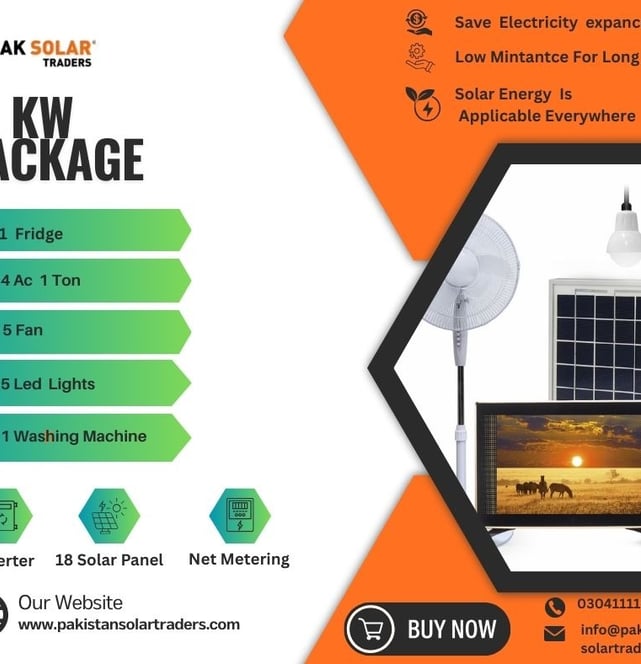Considering installing a 5kw solar system
In the event that you are not exactly sure how big this 5Kw Solar system is than Pakistan Solar Traders can Give options. How much it will cost you on average? , We’ve got covered! Below to determine exactly how large the 5kw solar system in Pakistan is appropriate for small and medium-size houses.. We additionally investigate the 5kW solar systems price in Pakistan likewise yield, returns and – all the more significantly – the amount you can save. It’s doesn’t matter 5kW solar systems for home 5kw solar system for office in Pakistan we are requiring a lot of energy to produce and save.
5kW (5000) Watt Solar System Components:
Solar Panel: 5000 Watt Tier 1 144-cell monocrystalline panels with a 25-year warranty.
The Solar Inverter – Includes one easy-to-install Hybrid inverter with reliable performance at the right price.
Solar battery
Mounting Structure – Iron racking mounts the solar panels to your roof.
DC Wiring / AC Wiring– Wire, conduit, fittings, breakers, AC/DC Disconnects (if required).
DB BOX – Circuit Breakers, Change Over, Light
Connectors / Accessories – junction boxes and a sub panel (if required). All these items can be provided at the time of Installation.
System Monitoring – Free with every Bluetooth or wifi View and analyze your solar energy production in real-time.
System Design and Financial Analysis – We’ll custom engineer this system for your roof and calculate the payback on your solar investment.
5Kw Solar System Options:
Back-up Time:
Load Back-up
5000 watts 1 hours
2500 watts 2 hours
1500 watts 3.2 hours
Which Loads can run on a 5kw solar system Off-Grid
1 HP Motor, 1.5 Ton Inverter AC, 1 Fridge, 1 Water Dispenser, 1 LCD TV, 5 Fans, 19 LED Lights
Typical Power Output of 5000 watts
Most Importantly typical power output 5000-watt solar system Depending a number of factors, the actual power output of a 5kW solar power system will vary. These factors include:
-Geographical location of the system and the expected daily and annual solar irradiation and cloud cover levels there
–Orientation and tilt angle of the solar panel array
–Whether there is any shade cast on the panels
-Actual operating temperature of the panels
-The performance of the individual components (e.g. First of all, panels and the inverter)
In perfect condition, where your installation is fully efficient and strong sunlight, installing your 5kW will produce 3500 watt-hours (kWh) of electricity in one hour (3.5 KW x 1 hour = 3.5 kWh). In 5 hours, it will produce 17.5 kWh. So the installation of 5kW will generate 600 Units which is enough electricity to cover about half the needs of most people of electricity.
Lamentably, in spite of the fact that we don’t live ideally. In reality, many factors really drop the measure of power your framework can deliver: the shade, area, course of sun oriented boards, and even productive wiring and your inverter. In the wake of thinking about the individual circumstance, the sum delivered by the boards is probably going to be lower.
Type of Solar Panels in 5000-watt solar system
You can see that, with an increased wattage plate (which means that it can produce more electricity at one moment), you need fewer panels. Obviously, the more efficient the plate, the higher the price. For most people, standard, 450, 540,590, 650 watt panels fit the bill well, balancing performance and cost.
How Much Roof Top Space Required?
On Average size of solar panel 450 watts to 540 are around 3.6 feet crosswise over 8 feet, totalling 24.5 square feet. This implies the establishment of 5000 solar System comprises of 9-10 plate required about 25-35 m2 of roof space, depending on the wattage of the panels and how they’re tilted.
5KW Solar System Financial Returns
The financial returns from a 5kW solar installation are a bit harder to work out, and mainly contingent on whether or not a solar feed-in tariff is available to the owner/operator of the system. Solar Feed-in Tariff schemes pay solar system owners a set amount for each unit of solar power that they do not use themselves and instead export to the electricity grid. Returns depend not only on the output of the system, but also how it is utilised by those whose home or business it is attached to in light of the presence or absence of feed-in incentives.
Even Before You GO Solar, Think Energy Efficiency First
More details and installation contact us 0304 1111 988

